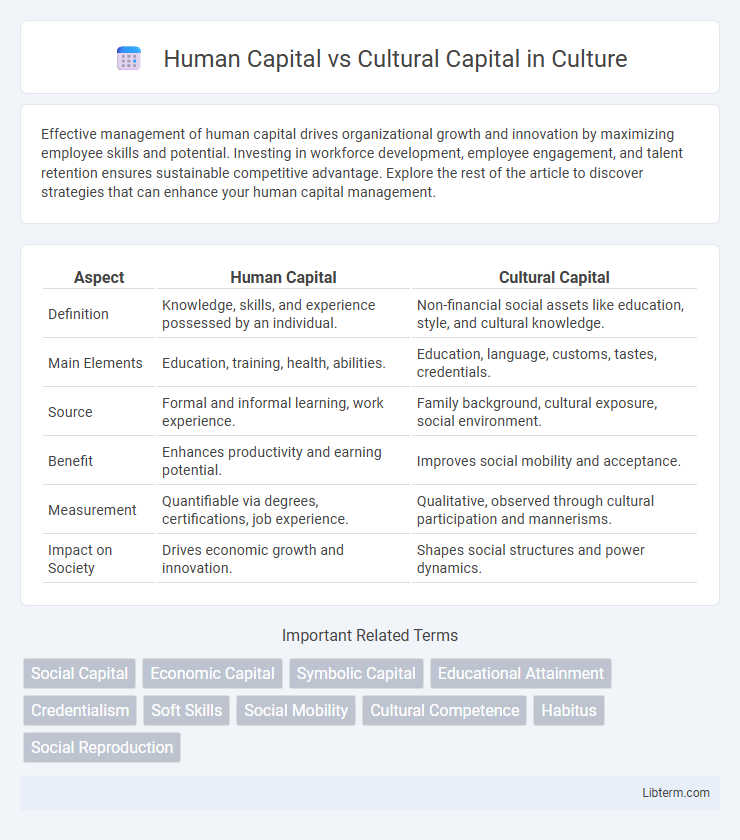Effective management of human capital drives organizational growth and innovation by maximizing employee skills and potential. Investing in workforce development, employee engagement, and talent retention ensures sustainable competitive advantage. Explore the rest of the article to discover strategies that can enhance your human capital management.
Table of Comparison
| Aspect | Human Capital | Cultural Capital |
|---|---|---|
| Definition | Knowledge, skills, and experience possessed by an individual. | Non-financial social assets like education, style, and cultural knowledge. |
| Main Elements | Education, training, health, abilities. | Education, language, customs, tastes, credentials. |
| Source | Formal and informal learning, work experience. | Family background, cultural exposure, social environment. |
| Benefit | Enhances productivity and earning potential. | Improves social mobility and acceptance. |
| Measurement | Quantifiable via degrees, certifications, job experience. | Qualitative, observed through cultural participation and mannerisms. |
| Impact on Society | Drives economic growth and innovation. | Shapes social structures and power dynamics. |
Defining Human Capital: Skills, Knowledge, and Education
Human capital encompasses the skills, knowledge, and education individuals acquire, which enhance their productivity and economic value. It includes formal education, technical training, and experiential learning that contribute to an individual's ability to perform tasks effectively. Investments in human capital drive innovation, increase employability, and support economic growth by improving individual expertise and competencies.
Understanding Cultural Capital: Social Assets and Influence
Cultural capital encompasses social assets such as education, intellect, style of speech, dress, and physical appearance that contribute to social mobility and influence within a community. Unlike human capital, which primarily refers to skills and knowledge acquired through formal education and training, cultural capital reflects inherited social advantages and cultural knowledge that shape access to power and resources. Understanding cultural capital highlights how social influence and prestige are maintained and reproduced across generations through non-economic means.
Historical Perspectives on Capital Theory
Historical perspectives on capital theory distinguish human capital as the skills, education, and knowledge individuals accumulate to enhance economic productivity, while cultural capital encompasses non-economic assets like social habits, language proficiency, and cultural knowledge that influence social mobility. Early theorists like Pierre Bourdieu emphasized cultural capital's role in perpetuating social inequality through inherited cultural competencies, contrasting with economists such as Gary Becker who highlighted human capital investment's impact on labor market outcomes. The evolving discourse integrates both concepts, recognizing that economic success and social positioning depend on the interplay between acquired skills and culturally embedded advantages.
Key Differences Between Human and Cultural Capital
Human capital refers to the skills, knowledge, and experience possessed by an individual, enhancing their economic productivity and job performance. Cultural capital encompasses the non-financial social assets, such as education, style of speech, dress, or physical appearance, that influence social mobility and status within a community. Key differences include human capital's direct impact on economic value through work-related competencies, while cultural capital affects social positioning and access to resources within societal structures.
Importance of Human Capital in Economic Development
Human capital, encompassing skills, education, and experience of the workforce, is a critical driver of economic development by enhancing productivity and innovation. Investments in human capital lead to higher labor efficiency, increased technological adoption, and improved competitiveness in global markets. Unlike cultural capital, which influences social mobility and identity, human capital directly impacts economic growth through quantifiable contributions to output and income.
The Role of Cultural Capital in Social Mobility
Cultural capital, comprising education, skills, tastes, and social habits, plays a crucial role in social mobility by influencing access to opportunities and social networks beyond economic resources. Unlike human capital, which emphasizes individual knowledge and abilities, cultural capital shapes how individuals navigate institutional structures and gain acceptance in higher social strata. Programs that enhance cultural capital, such as arts education and language proficiency, have demonstrated significant impact on reducing social inequalities and improving upward mobility.
Intersections: How Human and Cultural Capital Interact
Human capital, encompassing skills, education, and experience, intersects with cultural capital, which includes knowledge, norms, and social practices, to shape individual opportunities and social mobility. This interaction influences access to resources, as culturally resonant skills can enhance the value of human capital in specific social contexts. Research shows that individuals leveraging both types of capital effectively experience higher economic and social returns, highlighting the importance of their dynamic interplay.
Measuring and Valuing Each Form of Capital
Measuring human capital often involves quantifying education, skills, work experience, and productivity metrics to reflect an individual's economic value and potential contribution to an organization. Cultural capital is assessed through indicators such as language proficiency, social habits, and cultural knowledge that influence social mobility and access to resources within a specific social context. Valuing human capital emphasizes economic returns and employability, while cultural capital's value is more nuanced, affecting social status, relationships, and opportunities in both educational and professional environments.
Impacts on Workplace Diversity and Inclusivity
Human capital, encompassing employees' skills, knowledge, and experiences, directly influences workplace diversity by bringing varied expertise and perspectives essential for innovation and problem-solving. Cultural capital, including shared values, norms, and social networks, shapes inclusivity by affecting how diverse backgrounds are recognized and integrated within organizational culture. Together, these forms of capital determine the effectiveness of diversity initiatives and the creation of an inclusive environment that values both individual competencies and cultural differences.
Investing in Human and Cultural Capital for the Future
Investing in human capital through education, training, and skill development enhances workforce productivity and innovation, driving economic growth and competitiveness. Simultaneously, nurturing cultural capital by fostering values, traditions, and social networks strengthens community resilience and social cohesion. Integrating both human and cultural capital investments ensures sustainable development and prepares societies for future challenges in a globalized economy.
Human Capital Infographic

 libterm.com
libterm.com